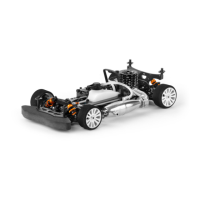36
GEARING
Proper gearing is one of the most essential tuning options required to maximize the performance potential of your NT1. The key to proper gearing
is fi nding and maintaining the best rollout and overdrive ratio for each track environment, engine/chassis setup and driving style.
Rollout is the distance the car will travel in one revolution of the engine (with clutch engaged). Pinion and spur gears are used to generate the desired
rollout, considering the diameter of the tires mounted. Rollout determines top speed and acceleration.
Typically, a higher rollout will provide less acceleration and more top speed, and a lower rollout will be quicker off the line, but with less top speed.
It is possible, however, to lose too much low-end torque needed to effectively accelerate the weight of the car out of a slow corner by undergearing
to a smaller rollout, or having an engine at too high RPM with very little useable torque.
However, if the engine is overgeared at too high of a rollout, the excessive torque will put undue strain on the engine.
Overdrive is determined by the use of different mid-side pulleys, which affects the rotation speeds of the front and rear wheels, ultimately affecting the
driving characteristics of the car. A neutral overdrive ratio (1:1) allows the front and rear wheels to rotate at the same speed, giving neutral driving
characteristics. A car that is overdriven (example, overdrive ratio of 1.04:1) has the front wheels rotating faster than the rear wheels, giving the car
the driving characteristics of a front wheel drive car that “pulls” its way out of corners.
In order to accelerate the process of dialing your NT1 at a track that you have never raced at, you should ask drivers who are familiar with the track
about their rollout and overdrive. Using that information — with the calculations explained in this section — should help you to set the rollout and
overdrive of your NT1 to a good starting point, regardless of the other differences between cars.
A “drivetrain ratio” (DTR) is the ratio of all the internal gears from the transmission,
including differentials and pulleys.
The front and rear DTR values may differ depending on mid-side pulley used.
The rear DTR of the XRAY NT1 is permanently set to 2.05.
The front DTR value may be changed by using different mid-side pulleys:
• When using the 26T mid-side pulley,
the front DTR is 2.05 (1:1 overdrive)
• When using the 25T mid-side pulley,
the front DTR is 1.97 (1.04:1 overdrive)
The ratio between front and rear DTR values
is the “overdrive ratio” described later.
DRIVETRAIN RATIO (DTR) — INTERNAL RATIO
GEARING
With the optional XRAY Multi-Diff™ set to “front one-way” mode, both
outdrive shafts (left and right) are not connected to each other, nor to
the front main axle. This mode combines the characteristics of a solid
axle and a differential.
XRAY MULTI-DIFF™ — FRONT ONE-WAY AXLE
Off-power & braking:
(corner entry & mid-corner)
Front inner and outer wheels rotate forward independently of each other, making axle behave like a
front differential. There is NO front braking.
On-power:
(mid-corner and corner exit)
Both front wheels rotate with front main axle (locked in one-way bearings) at the same speed, making
the front axle behave like a front solid axle. Introduces some on-power understeer.
Best combined with:
Rear differential or solid rear axle (if available).
Typically used on:
High-traction tracks. The car leans towards on-power understeer and the track does not require
braking for the corners. Will give maximum off-power steering and increase effi ciency (more runtime).
Best suited to a smooth driving style.
Considerations:
• The front one-way axle allows you to use slightly bigger rear tires than front tires, and to have the
rear wheels overdrive the front wheels. In that situation, when the rear wheels lose traction the front
wheels engage and start helping to generate forward traction.
• It is very important to know that when using a front one-way axle, you get no front wheel braking.
While this gives you better steering response going into a corner, the effect may cause the rear of
the car to break traction more easily.
Outdrive shaft (Left)
Outdrive shaft (Right)
Front main axle
Cutaway view
PRIMARY DRIVE RATIO (PDR)
The “primary drive ratio” (PDR) is the ratio between the pinion and spur gear, and is one of the most straightforward way to change the overall drive ratio of
the NT1.
• Larger spur / smaller pinion = high (“long/tall”) PDR ratio = faster acceleration but lower top speed
• Smaller spur / larger pinion = low (“short”) PDR ratio = slower acceleration but higher top speed

